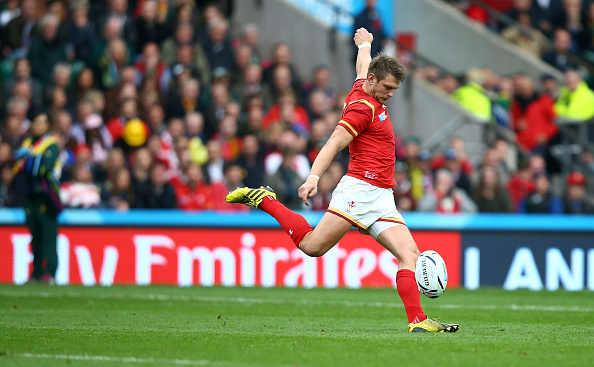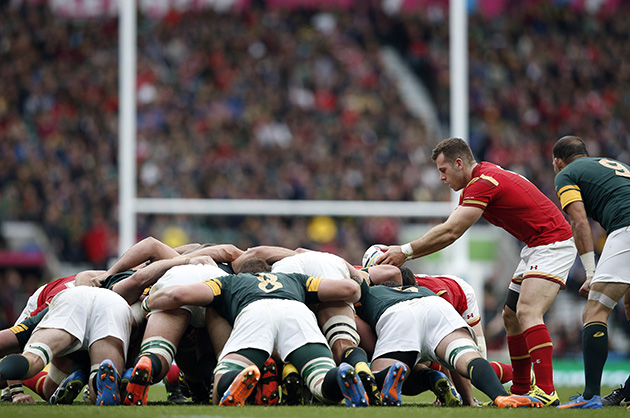The work-rate of Sam Warburton, the ability of Dan Biggar, solid scrums and lots of whistleblowing feature in this Wales analysis
Disappointedly content
Wales lost against South Africa, by 23-19, in yet another of those ‘defeats’ that pushed every Welsh person’s central nervous system to its limit. Yet despite the loss, and once every supporters’ internal organs had stabilised, there was a bizarre air of contentment. The reality is that a significantly depleted Wales couldn’t have done any more in this game, or the tournament as a whole. Barring the early misreading of Wayne Barnes’s breakdown interpretation, every player gave it everything. Dan Biggar was once again immaculate, providing Wales with a solidity of thought and execution worthy of a British & Irish Lions shirt.
Sam Warburton had his best game for 12 months and, along with Alun Wyn Jones and Luke Charteris, more than matched the almost freak-show size of the Bok pack. Jamie Roberts had the sort of carrying and defensive game that makes you think he could strip a quarry on his own, by hand, in about 20 minutes. And George North made a splendid return to form, carrying with the reckless aggression and gas for which he is renowned. But it wasn’t enough, and it certainly wasn’t enough to match the splendour of Duane Vermuelen’s offload for South Africa’s 74th-minute try. Wales have rather valiantly decided not to blame injuries for the loss against the Boks, but I’m quite sure that no one would blame them if they did.
Play the ref, early
I always thought that my mother’s obsession with a clean floor would take some beating, but that was until Wayne Barnes became a professional referee. Barnes, quite rightly, is a stickler for a player’s behaviour on the deck. Any lazy rolling or negative body angles in the jackal, and he’s blowing his whistle like an extra in a 1990s Prodigy video.
This is exactly what happened in the first half between Wales and South Africa, and it allowed Handre Pollard to convert some very simple penalty kicks. Wales were relatively slow to spot that Barnes didn’t like their approach at the breakdown and it wasn’t until the second half that they chose to ‘stand off’ the ruck – unless there was a clear opportunity to pinch the ball. But by that point Wales had already coughed up 12 points, with the Boks having to exert very little energy to secure them.
Dan Biggar has gone up a level
Wales can’t possibly have the best outside-half in the world, can they? It just doesn’t seem right. The best tens in the world are usually from down south, or on the odd occasion England. However, if there is a better stand-off other than Biggar at this World Cup then I haven’t seen him play – his stock has risen so much during this tournament that it’s triggered alarms on Wall Street.
Against the Boks, as with all of his performances in this competition, he was exemplary. He almost seems to have created a new position on the field, a sort of full-back/outside-half hybrid, where his aerial and ‘bomb’ work is as effective as his distribution and line kicking. His role in Gareth Davies’s 17th-minute try was beautiful and a highlight of Wales’ overall campaign. Sticking up an accurate bomb, regaining it in full stride, running ten metres and then offloading the ball, mid-tackle, is about as difficult a series of skills as you’ll find in rugby. Not to mention his clever drop-goal with the clock running over 40 minutes. Well played, sir.
Gareth Anscombe and Tyler Morgan stepped up
Gareth Anscombe and Tyler Morgan were put in very difficult positions against South Africa – both physically and figuratively. Not only did they have to play in the biggest game of rugby that Wales have faced during the past four years, but they were in positions where the quality of the injured players who they had replaced was so high that direct comparisons would obviously be made.
However, much to their credit, both performed admirably. Morgan didn’t miss a tackle in the most defensively intense channel on the field. Anscombe too, had a very good game and more than proved that he deserved his place in the Welsh squad. His experience in Super Rugby was clear against South Africa, where his ability to catch a bomb and pass a player into space as opposed to simply kicking deep gave Wales an extra option. Wales may have lost as a team, but both won quite significant individual battles. The Six Nations squad awaits for both.
Scrum, finally fixed
A match fit Samson Lee made a big difference to the scrum and delivered the first truly solid scrum platform of the tournament for Wales. Whilst it wasn’t enough to win the game, it certainly meant that Wales were able to execute their gainline staple from the set-piece.
With the ball neatly passing through the 920kg vending machine, Gareth Davies was able to set up Biggar, who in turn allowed Jamie Roberts to blast through the first two tackles and set up the second phase in midfield – quite how anyone is able to repeatedly tackle Roberts is beyond me. As such, it allowed Roberts to be Wales’ second highest ball-carrier with 49 yards – each yard usually with 200kg of Bok strapped to his body. The scrum fix has obviously come too late for the competition and was a factor in Wales’ exit, but it is positive news for the Six Nations – Wales couldn’t continue scrummaging as they were.
For the latest Rugby World subscription offers, click here.










